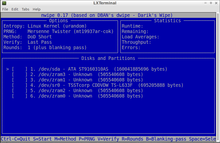Darik's Boot and Nuke
Darik's Boot and Nuke, also known as DBAN /ˈdiːbæn/, is a free and open-source project hosted on SourceForge.[2] The program is designed to securely erase a hard disk until its data is permanently removed and no longer recoverable, which is achieved by overwriting the data with pseudorandom numbers generated by Mersenne Twister or ISAAC. The Gutmann method, Quick Erase, DoD Short (3 passes), and DOD 5220.22-M (7 passes) are also included as options to handle data remanence. DBAN can be booted from a CD, DVD, USB flash drive or diskless using a Preboot Execution Environment. It is based on Linux and supports PATA (IDE), SCSI and SATA hard drives. DBAN can be configured to automatically wipe every hard disk that it sees on a system or entire network of systems, making it very useful for unattended data destruction scenarios. DBAN exists for x86 systems.[3]
.png) | |
 | |
| Developer(s) | Darik Horn |
|---|---|
| Stable release | 2.3.0
/ June 4, 2015 |
| Operating system | Linux |
| Platform | x86 |
| Available in | English |
| Type | Secure erase |
| License | GPLv2[1] |
| Website | www |
DBAN, like other methods of data erasure, is suitable for use prior to computer recycling for personal or commercial situations, such as donating or selling a computer.[4]
Current status
In September 2012, Blancco of Finland announced its acquisition of DBAN.[5]
The most recent version of DBAN is 2.30, which was released on 4 June 2015.[6] Since that time DBAN development seems to have ended and the official website used by Blancco to market their Blancco Drive Eraser instead.[7]
nwipe

The dwipe program that DBAN uses has been forked and is available as a standalone command line program called nwipe, which is actively maintained by Martijn van Brummelen and released under the GNU General Public License 2.0 licence.[8][9][10][11]
nwipe was created to allow dwipe to be run outside DBAN, using any host distribution. It utilizes a simple text-based ncurses user interface. It is available as an installable package in the repositories of many Linux distributions, including Debian and Ubuntu.[9][12][13][14][15]
nwipe has also been incorporated in free software rescue toolkit packages, such as the All in One - System Rescue Toolkit, Parted Magic, shredos and SystemRescueCD.[9][16][17]
References
- DBAN (18 July 2008). "May I rebrand DBAN?". Retrieved 24 January 2012.
- Fitzgerald, Thomas J. (2005). "Deleted but Not Gone". The New York Times. Retrieved 2009-02-03. Published on November 3, 2005
- "DBAN version 2.0.0 download". Retrieved 3 November 2012.
- "Preparing Your Computer for Sell or Donation". analysisandreview.com.
- "Acquisition". September 2010. Archived from the original on 8 August 2014. Retrieved 1 August 2014.
- "Darik's Boot and Nuke - Browse /dban at SourceForge.net". sourceforge.net.
- "Darik's Boot and Nuke – DBAN". November 30, 2016.
- Rennie-Waldock, Nathan. "Unofficial fork of DBAN". Retrieved 24 December 2015.
- Beverley, Andrew (March 2010). "Nwipe". Archived from the original on 2018-02-07. Retrieved 10 August 2018.
- Vanbrummelen, Martijn (6 December 2017). "nwipe". github.com. Retrieved 22 February 2018.
- Free Software Foundation (2020). "Nwipe". directory.fsf.org. Archived from the original on 5 March 2020. Retrieved 5 March 2020.
- Canonical Ltd. (2019). "nwipe - securely erase disks". manpages.ubuntu.com. Archived from the original on 3 August 2019. Retrieved 5 March 2020.
- Launchpad (website) (15 March 2020). ""nwipe" package in Ubuntu". launchpad.net. Archived from the original on 16 October 2013. Retrieved 5 March 2020.
- Debian (2020). "Package: nwipe (0.25-1)". packages.debian.org. Archived from the original on 5 March 2020. Retrieved 5 March 2020.
- Techworld Staff (10 April 2018). "Best disk wiping tools for hard drives, smartphones and SSDs". techworld.com. Archived from the original on 26 August 2018. Retrieved 5 March 2020.
- Vreeland, Paul (2 January 2018). "All in One - System Rescue Toolkit". Retrieved 22 February 2018.
- Garcia, Pablo (26 April 2011). "Wipe Hard Drive Clean Using Free Software". Geeky Projects. Archived from the original on 6 June 2017. Retrieved 5 March 2020.